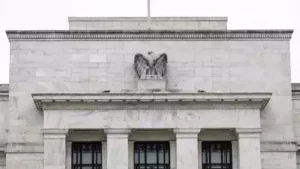
When the Federal Reserve announces its widely anticipated interest rate cut on Wednesday—the first in four years—the impact will extend far beyond the United States.
The magnitude of the initial cut and the overall scope of easing remain uncertain, especially as a looming U.S. election adds complexity for global investors and policymakers seeking direction from the Fed and hoping for a soft economic landing.
“We don’t yet know what kind of cycle this will be—whether it will be like 1995, with just 75 basis points of cuts, or more like 2007-2008, when cuts reached 500 basis points,” said Kenneth Broux, head of corporate research, FX and Rates at Société Générale.
1. FOLLOW THE LEADER
Earlier this year, as U.S. inflation proved more persistent than expected, investors began to wonder how much other central banks, such as the European Central Bank (ECB) or the Bank of Canada, could lower rates if the Fed held steady. The concern was that their currencies might weaken too much, adding to inflationary pressures.
Now that the U.S. is starting to cut rates, it offers relief to regions with weaker economies. Traders have increased bets on rate reductions by other central banks as expectations of Fed rate cuts grow. However, fewer cuts are anticipated in Europe, with the ECB and the Bank of England sounding more cautious about lingering inflation risks.
Confidence in the Fed starting its rate cuts has benefited global bond markets, which often move in sync with U.S. Treasuries. U.S., German, and British government bond yields are all set for their first quarterly decline since the end of 2023, when markets anticipated a Fed policy shift.
2. BREATHING ROOM
Lower U.S. interest rates could give emerging market central banks more flexibility to ease their own policies and support domestic growth. About half of the 18 emerging markets tracked by Reuters have already begun cutting rates in this cycle, primarily in Latin America and emerging Europe.
However, the uncertainty surrounding the U.S. presidential election adds complexity to the outlook.
“The U.S. election will play a major role here because different fiscal policies could complicate the rate-cutting cycle,” said Trang Nguyen, global head of emerging markets credit strategy at BNP Paribas. “We may see more idiosyncratic moves among central banks as a result.”
3. STRONG DOLLAR RELIEF?
Countries hoping that U.S. rate cuts will weaken the strong dollar and boost their own currencies might be disappointed. JPMorgan has pointed out that in three out of the last four Fed rate-cut cycles, the dollar actually strengthened after the first cut.
The dollar’s future will largely depend on how U.S. rates compare to those of other economies. Safe-haven currencies like the yen and Swiss franc could see their rate differentials with the U.S. almost halved by the end of 2025, while the British pound and Australian dollar may only gain a slight yield advantage over the dollar.
Unless U.S. rates drop significantly, the dollar is likely to remain attractive to foreign investors.
Asian currencies have already been responding to U.S. rate-cut expectations, with the South Korean won, Thai baht, and Malaysian ringgit all surging in July and August. China’s yuan has also erased its losses against the dollar for the year.
4. RALLY ON?
A global equity rally, which had stumbled recently due to growth concerns, could regain momentum if lower U.S. rates stimulate economic activity and avert a recession. Global stocks fell more than 6% in early August after weak U.S. jobs data.
“You often see a shaky market after the first rate cut because investors wonder why central banks are cutting,” said Emmanuel Cau, head of European equity strategy at Barclays. “But if a cut occurs without a recession, which fits the mid-cycle pattern, markets usually bounce back.”
Cau added that sectors like real estate and utilities, which benefit from lower rates, could outperform. A U.S. soft landing would likely also benefit Asian markets, although Japan’s Nikkei has fallen more than 10% from its July high due to the rising yen and increasing domestic rates.
5. TIME TO SHINE
In commodities, both precious and base metals such as copper are expected to benefit from Fed rate cuts. The demand outlook and a soft economic landing will be crucial, especially for base metals. Lower rates and a weaker dollar reduce the opportunity cost of holding metals and make them more affordable for buyers using other currencies, which could drive up prices.
“High interest rates have been a major obstacle for base metals, distorting physical demand through destocking and hurting capital-intensive sectors,” said Ehsan Khoman of MUFG.
Precious metals, particularly gold, may also gain from rate cuts. Gold, which typically has a negative correlation with yields, tends to outperform other metals during rate-cutting cycles. While it is already at record highs, investors should be cautious, according to John Reade from the World Gold Council.
“Speculators in the Comex gold futures market are already positioned for this,” said Reade. “It could turn out to be a case of buying the rumor and selling the fact.”
.
#everyday_information #forex #option #Binary_Option #trading #trader #goldstocks #forextrader #fx_trade_time #fxttime #USDollar #euro #JPY #GBP #chfcurrency
#dubai #UAENews #ksasaudiarabia #Syrian #iraq #kuwait #jordan #morocco #Libya #tunisia #algerian #Egypt #qatar #lebanon
#كل_يوم_معلومه #فوركس #خيارات_ثنائيه #تداول_عملات #بورصه #ذهب #فوركس_تريد_تايم #اف_اكس_تريد_تايم #دولار #يورو
#دبي #امارات #السعوديه #سوريا #العراق #الكويت #الاردن #المغرب #ليبيا #تونس #الجزائر #مصر #قطر #لبنان
.
www.fxttime.com/trade
